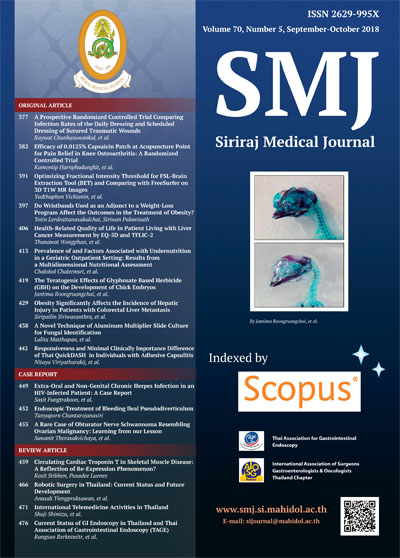Optimizing Fractional Intensity Threshold for FSLBrain Extraction Tool (BET) and Comparing with FreeSurfer on 3D T1W MR Images
Keywords:
Fractional intensity threshold; MRI; BET; FreeSurferAbstract
Objective: To find out the optimal Brain Extraction Tool (BET) parameter (fractional intensity threshold) for
measuring the brain volume compared with the standard manual method in our institute and to compare with
those of automated FreeSurfer software
Methods: This retrospective study was performed in 10 healthy adult subjects with data of 3D-T1W on 3T MR
machine. The manual gold standard brain volume measurements were done by two independent readers. The
automated segmentations using BET with varied parameters and FreeSurfer software were also performed. Then,
the two automated methods were compared with the manual tracing to make the optimal parameter by seeking for
the highest intraclass correlation coefficient (ICC) using SPSS software.
Results: The fractional intensity threshold for whole brain volume measurement of 0.1- 0.6 showed high ICC with
the manual gold standard (ranging from 0.639 to 0.748). The best value was 0.1, showing highest ICC of 0.748
(p < 0.006) with confidence interval of 95% equal to (0.242; 0.932). There were no optimal parameters for right and
left hippocampus volume measurement by BET due to very low ICC between BET and the reader (ICC ranging
from 0.017 to 0.139 and from 0.012 to 0.110, for the right and left hippocampus volume, respectively). The ICC
values of the automated FreeSurfer method with the manual tracing were also very low (0.063, 0.068, and 0.063 for
right, left and bilateral hippocampi respectively).
Conclusion: The optimal BET parameter (fractional intensity threshold) for automated brain volume measurement
in our institute is 0.1 similar to the suggested value by prior study with high agreement (ICC=0.748) to the manual
method.
Downloads
Published
How to Cite
Issue
Section
License
Authors who publish with this journal agree to the following conditions:
Copyright Transfer
In submitting a manuscript, the authors acknowledge that the work will become the copyrighted property of Siriraj Medical Journal upon publication.
License
Articles are licensed under a Creative Commons Attribution-NonCommercial-NoDerivatives 4.0 International License (CC BY-NC-ND 4.0). This license allows for the sharing of the work for non-commercial purposes with proper attribution to the authors and the journal. However, it does not permit modifications or the creation of derivative works.
Sharing and Access
Authors are encouraged to share their article on their personal or institutional websites and through other non-commercial platforms. Doing so can increase readership and citations.











